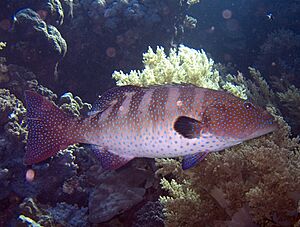Roving coral grouper facts for kids
The roving coral grouper (Plectropomus pessuliferus), also known as the spotted coral grouper, is a type of ray-finned fish that lives in the ocean. It belongs to a group of fish called groupers. These fish are part of the same family as sea basses. You can find the roving coral grouper in the Indo-Pacific region, which includes areas like the Red Sea and the Coral Triangle.
Quick facts for kids Roving coral grouper |
|
|---|---|
 |
|
| Conservation status | |
| Scientific classification | |
| Synonyms | |
|
Contents
What Does It Look Like?
The roving coral grouper has a strong, long body. It can grow up to about 120 centimeters (nearly 4 feet) long! Its body is usually brown to orange-red. It has many small blue spots with dark edges. Some of these spots on its head and sides are long, like vertical lines. The lower part of its body has fewer spots. Often, there's a blue ring around its eye, but it might be broken.
This fish has two main fins on its back. The front fin has 7 to 8 sharp spines, and the back part has 10 to 12 soft rays. Its tail fin is mostly straight in adult fish.
Where Does It Live?
The roving coral grouper lives in the Indo-Pacific ocean. You can find it from the Red Sea all the way down the East African coast to Mozambique and Madagascar. It also lives across the Indian Ocean to the Coral Triangle in the Western Pacific Ocean. Even though it's found in a wide area, it's quite a rare fish to spot.
Its Home and Habits
These groupers make their homes in coral reefs. They like shallow lagoons and reefs that face the open sea. They can live at depths from about 25 meters (82 feet) down to 147 meters (482 feet).
The roving coral grouper is a carnivore, which means it eats other animals. Its main diet includes smaller fish and crustaceans like crabs and shrimp.
Sometimes, these clever fish work together to hunt! They team up with other animals like the giant moray eel (Gymnothorax javanicus), the humphead wrasse (Cheilinus undulatus), or even the big blue octopus (Octopus cyanea). This cooperative hunting helps them catch more food.
About Its Name
The roving coral grouper was first officially described by an American fish expert named Henry Weed Fowler in 1904. He gave it the scientific name Plectropoma pessuliferum. The place where it was first found and described was Padang in Sumatra.
How People Use This Fish
People catch the roving coral grouper using different methods. These include spears, hand lines, gill nets, and traps. In places like the Maldives, this fish is very valuable. It is often sent to Southeast Asia to be sold in the live reef fish trade.
Images for kids




